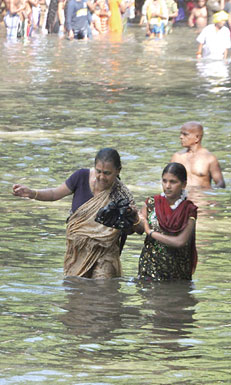News
Pipe-borne water and sewer facilities for Kataragama sacred city
View(s):The Cabinet has granted approval for an over two-billion-rupee sewerage development project for the sacred city of Kataragama.
The move is mainly aimed at ensuring that the Menik Ganga, the main source of water supply in the area, is not further polluted leading to serious environmental hazards.

Pilgrims take a dip in the Menik Ganga
The funding will come from Unicredit Bank, Austria. The bank will contribute Rs. 1, 545.12 million and the Treasury Rs. 585.41 million.
Water Supply and Drainage Minister Dinesh Gunawardena, who made the recommendation, has told his ministerial colleagues in a memorandum that the project is designed to provide pipe-borne water and sewer facilities for pilgrim rests, hotels and offices around the city limits to avoid further pollution of the Menik Ganga and surrounding areas.
Minister Gunawardena has pointed out that over the past two decades the Kataragama sacred city has developed rapidly. Due to this, domestic water consumption and the demand for sewerage connections have increased significantly. The capacity of the existing sewerage system is inadequate to meet the growing demands, he has pointed out.
Mr. Gunawardena added: “The sewage disposal system for Kataragama was originally planned to be implemented in two stages to serve the entire sacred city area. However, only Stage 1 of the project was completed in 1983 and since then, it has been maintained by the National Water Supply and Drainage Board (NWSDB).
As Kiriwehera, Sella Kataragama Road and Devalaya premises were not covered under Stage 1, several gully bowsers had to be employed continuously during the festival period to empty the common toilets in the Sacred City area.”
The minister said the small diameter sewer lines in the existing sewer network got blocked frequently. “During rainy days, the existing sewerage system is not capable enough to cope with the load and the resulting overflow of sewage causes direct pollution of Manik Ganga, the only source of drinking water for Kataragama. As such, there were incidents (sic) of water source pollution in the past owing to direct discharge of wastewater to Menik Ganga.”
According to Minister Gunawardena, the project will “increase the coverage area especially by connecting the hotels, pilgrim rests and the Devalaya premises which otherwise would cause considerable pollution of Menik Ganga.”
Follow @timesonlinelk
comments powered by Disqus














